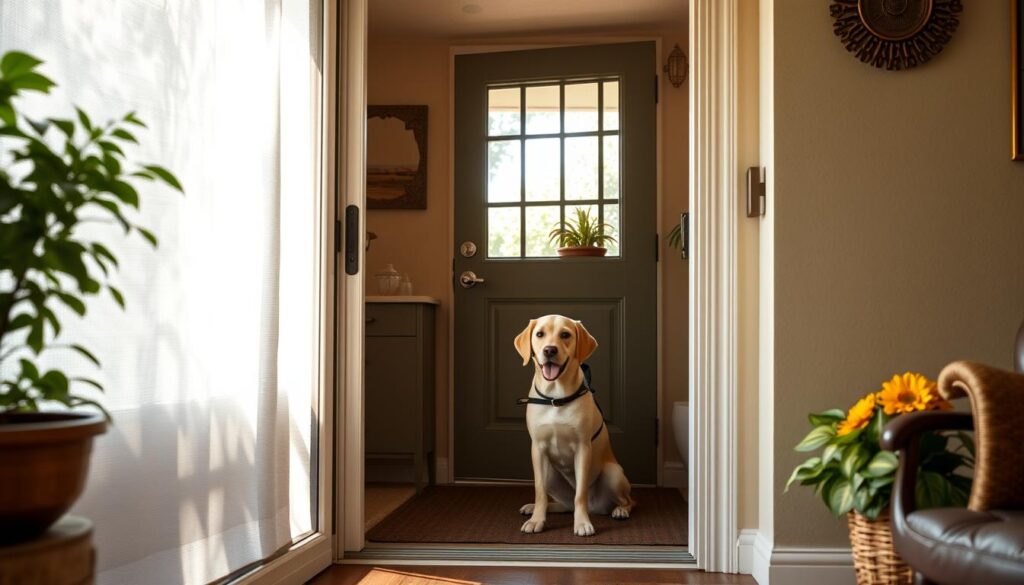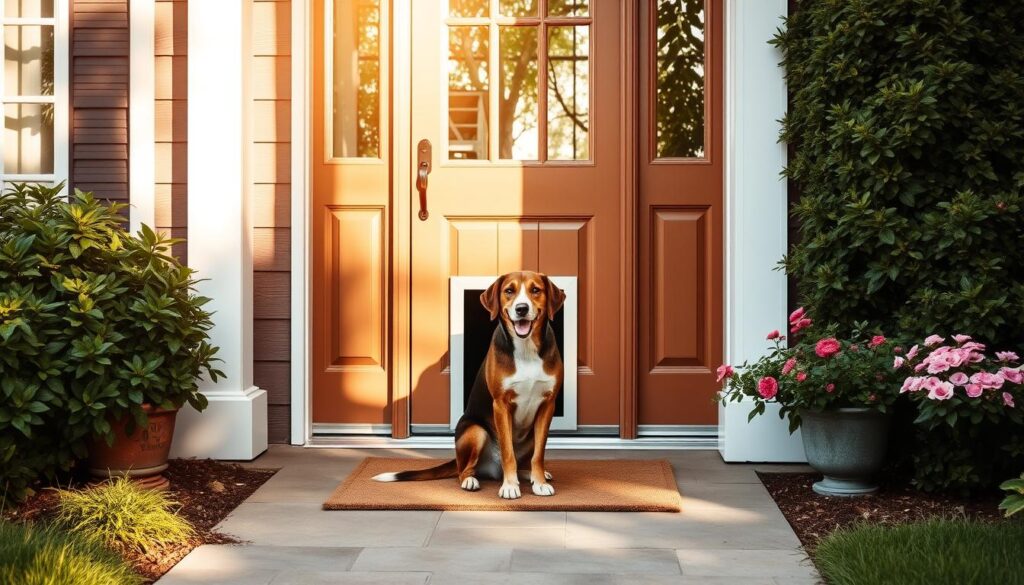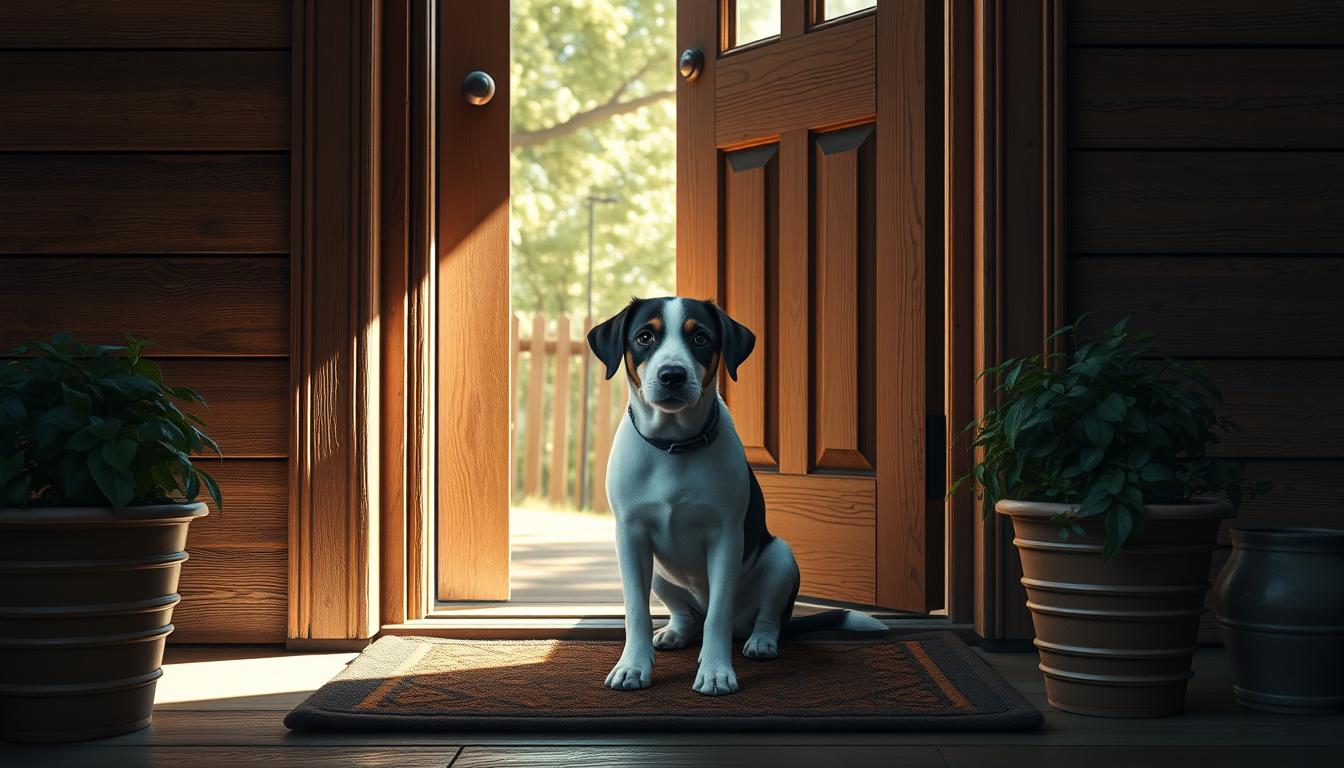Dog and Door As a dog owner, you know how important good behavior is, especially at home. How your dog acts at doors can affect their safety and your household’s peace. We’ll show you how to teach your dog to behave well at the door.
Key Takeaways
- Understand common door-related behavior issues in dogs and the safety risks they pose.
- Master essential commands like “Wait” to establish door manners and boundaries.
- Create a positive training environment and utilize effective tools to reinforce desired behaviors.
- Manage visitors and introduce dog doors safely to prevent undesirable door dashing or escape attempts.
- Troubleshoot and maintain long-term door etiquette through advanced training techniques.
Understanding Door-Related Behavior Issues in Dogs
If you own a dog, you might have seen some odd behaviors around doors. Dogs might jump up excitedly or bark a lot. Knowing why they act this way is key to fixing the problem.
Common Door Rushing Behaviors
Dogs often want to rush through doors. They might be eager to meet people, get outside, or check out new places. This urge can come from excitement, fear, or not being well-trained.
Why Dogs Get Excited at Doors
Doors can be thrilling for dogs. They might think of them as a chance to go for a walk, meet friends, or play outside. This excitement can lead to bad behaviors like jumping or trying to run through the door.
Safety Risks of Poor Door Manners
A dog that doesn’t behave well at doors can be dangerous. They might crash into things, run away, or get hurt. It’s important to teach them good door manners to keep everyone safe.
Understanding why your dog acts a certain way at doors is the first step. Then, you can start training them. The next part will talk about important commands for door training.
Essential Commands for Door Training Success
Starting dog door training with a few key commands is key. These commands help your dog learn good door manners and stay safe. Let’s look at the essential commands for door training success.
The “Sit” Command
Teaching your dog to sit and stay at the door is vital. This command helps you control your dog’s actions. It stops them from rushing out or greeting visitors too eagerly. Practice the sit-stay in different doorway situations to improve your dog’s reliability.
The “Leave It” Command
The leave it command is crucial for door training. It teaches your dog to ignore distractions like people or animals. Regular practice helps your dog learn to stay calm when the door opens.
| Command | Purpose | Benefits |
|---|---|---|
| Sit | Control dog’s actions at the door | Prevents rushing, allows for controlled exits/entries |
| Stay | Keep dog in place at the door | Builds self-control and patience |
| Leave It | Ignore distractions at the door | Prevents dashing out, improves focus |
Learning these essential commands is the first step to your dog’s door training success. With patience and regular practice, your dog will learn to safely and calmly go through doors. This will make both of you happier and less stressed.
Creating a Positive Door Training Environment
Creating the right training space is key for teaching your dog good door manners. Set up special areas for training, manage distractions, and pick the best tools. This way, your dog will learn in a positive and fun way.
Setting Up Training Zones
Choose specific spots in your home for door training. These areas should be quiet and free from distractions. This helps your dog focus on learning. Use a spot near the entry or a screen door with a dog door to practice in the right place.
Managing Environmental Distractions
Keep the training area calm and quiet. Reduce noise and keep other pets or people away. This helps your dog pay attention and learn better.
Choosing the Right Training Tools
- Use a leash or long line to keep control and stop bad behavior at the door.
- Use positive reinforcement like treats or praise to reward good behavior at the door.
- Try visual markers like mats to show your dog where to go and what to do.
By making a good training space, handling distractions, and using the right tools, you can help your dog learn door manners. Always use positive methods and be patient. This will help your dog learn and grow.
The “Wait” Command: Foundation of Door Manners
Teaching your dog the “wait” command is key for good door manners. This simple command helps prevent bad behaviors like rushing through doors. It ensures your dog waits patiently, making door interactions safer and more controlled.
The “wait” command makes your dog pause before moving. It’s useful for many situations, like using a dog door for sliding glass doors or saying hello to visitors.
- Begin teaching the “wait” command in a quiet place. Use a treat to get your dog to sit or stand, then say “wait” and hold out your hand.
- Slowly make the wait time longer. Give your dog praise and a treat when they stay still.
- Practice the “wait” command near the doggie door for sliding glass door or other doors. Start with less distraction and add more as your dog gets better.
Training the “wait” command takes patience and consistency. With time, your dog will learn to control their impulses and be a well-behaved door companion.
“The ‘wait’ command is the foundation of door manners. Mastering this cue will give you the control and safety you need when navigating doors with your dog.”
Adding the “wait” command to your dog’s training helps them make better choices at the door. It reduces the chance of accidents or escapes. This skill is crucial, whether you’re using a dog door for sliding glass door or welcoming guests at the front door.
| Command | Purpose | Training Tips |
|---|---|---|
| “Wait” | Teaches your dog to pause and hold their position until given the okay to proceed |
|
Teaching Your Dog Door Boundaries and Thresholds
It’s key to teach your dog to respect door boundaries. This stops them from rushing through or getting out. Here are ways to teach your dog these important lessons.
Establishing Physical Boundaries
Begin by setting up a “door zone” with barriers like baby gates or X-pens. This shows your dog where they can’t go. As they get used to it, you can move the barrier further back.
Using Visual Markers
- Use bright tape or stickers to show where your dog should stop.
- Put up a sign or colorful ribbon at the door to mark the boundary.
- Teach your dog to wait on a mat before going through the door.
Reinforcing Threshold Rules
Always praise your dog for waiting calmly at the door. This positive feedback will make them more likely to wait. If they rush, gently guide them back and try again.
These methods work for all types of doors, including dog doors for walls and large dog doors. By setting and enforcing clear rules, your dog will learn to respect the door forever.
Dog and Door: Managing Visitor Greetings
Welcoming guests at the door can be tough for dog owners. Your dog’s excitement might cause them to jump, bark, or rush out. But, with the right training, you can teach them to greet visitors calmly.
Using a dog door for screen door or a door with doggie door is a good idea. These options let your dog see and interact with guests without rushing to the door. This setup helps your dog learn to greet visitors politely.
- First, teach your dog the “wait” command. This helps them stay back until you say it’s okay to come forward.
- When guests arrive, reward your dog for being calm. If they get too excited, gently guide them back to calmness.
- Using a leash or baby gate can also help control your dog’s movements during greetings.
With patience and consistent training, your dog will learn to greet visitors safely and calmly. It’s important to make sure your dog sees guests as a positive experience. This way, they won’t jump and bark too much.
“Proper door training is essential for the safety and comfort of both your dog and your guests.”
By using these strategies and a dog door for screen door or a door with doggie door, you can manage your dog’s excitement. This ensures their greetings are polite and under control.

Installing and Using Dog Doors Effectively
Adding a dog door to your home can change your life and your dog’s. It lets your pet go outside easily and can save energy. Knowing about dog door options and how to train your dog is key.
Types of Dog Door Solutions
There are many dog doors to choose from. You can pick from simple flap-style doors to high-tech electronic ones. The right choice depends on your dog’s size, your home, and what you need. Electronic doggie doors are secure and save energy, but flap-style doors are cheaper.
Training Tips for Dog Door Usage
Teaching your dog to use a dog door takes time and patience. Begin by letting your dog get used to the door with treats. Then, teach them to go through it, making sure they feel safe. Always watch your dog during the first few days to avoid any problems.
Getting a dog door can really improve your pet’s life. By picking the right one and training your dog well, you can make it a great addition to your home.
“A happy dog is a well-exercised dog, and a dog door can be the key to unlocking that exercise and independence.”
Preventing Door Dashing and Escape Attempts
Dealing with a dog’s door dashing and escape attempts can be tough for pet owners. These behaviors are not just risky but also frustrating. But, with the right training, you can stop your dog from running out every time the door opens.
Dogs have a natural urge to explore and chase. The excitement of a door opening can make them run. Teaching your dog the “wait” or “stay” command is key. It helps them stay calm and focused, even when the door is open.
- Begin by practicing the “wait” command in quiet places. Gradually increase the time and distance as your dog gets better.
- Use door-specific training. Reward your dog for staying put when you open and close the door, without running out.
- Think about getting a dog door. It gives your pup a special way out, reducing the urge to run through the main door.
By being proactive with door training, you can make sure your dog and door get along. This keeps your dog safe inside while still letting them go outside under your watch. With patience and consistency, you can avoid those scary moments of a possible escape. And you’ll enjoy the peace of mind that comes with a well-trained, door-smart pup.

“A well-trained dog is a joy to have around, and proper door etiquette is a crucial part of that training. With the right techniques, you can ensure your pup stays safe and secure, even when the door is open.”
Advanced Door Training Techniques
Once your dog knows the basics of door manners, it’s time to get more advanced. Focus on distance control and managing multiple dogs at the door.
Distance Control Exercises
It’s important for your dog to stay away from the door when it opens and closes. Start by having them stay a few feet away and gradually increase the distance. Reward them with praise and treats for staying calm and focused.
Multiple Dog Management
Training multiple dogs to use the door can be challenging. Teach them who goes first and use commands like “wait” and “go ahead.” Make sure each dog knows their place and waits patiently for their turn. Reward them for being calm and cooperative.
Learning advanced door training takes time and effort. But, it makes your dog safer and more well-behaved. These skills work with any type of dog door, bringing peace of mind to your family.
Troubleshooting Common Door Behavior Problems
Having a dog is joyful, but dealing with door issues can be tough. Whether it’s a dog screen door or a dog door for sliding glass door, knowing how to fix common problems is key. It helps keep your home peaceful.
One big problem is dogs barking too much at the door. This can happen when people come over, when the mail arrives, or even when you open the door. To stop this, teach your dog to ignore door sounds and movements. Use positive training to help them learn.
Another issue is dogs scratching at doors. This can hurt your home and your dog’s paws. Give them places to scratch like mats or posts. Also, use things like sticky tape or citrus sprays to keep them away from the door.
Some dogs have trouble going in and out. They might get too excited or anxious when using a dog screen door or dog door for sliding glass door. Teach them to wait calmly before going outside. Make going through the door a positive experience.
| Behavior Issue | Possible Solutions |
|---|---|
| Excessive Barking |
|
| Scratching at Doors |
|
| Difficulty with Transitions |
|
With patience, consistency, and the right training, you can teach your dog good door manners. This makes your home safer and happier for everyone.
Maintaining Long-Term Door Etiquette
Teaching your dog good door manners is a long-term effort. It needs consistent practice and adjusting as your dog grows and your home changes. Make sure to include regular training in your daily routine. Also, always reinforce the good behaviors you want to see.
As your dog gets used to the dog doors, keep practicing the “wait” command. Make sure they know not to cross the threshold without permission. Reward them for staying calm and controlled at the door. Remember, it takes time for them to learn this important skill.
Also, be ready to change your training methods as your dog ages or your family grows. For example, older dogs might need more practice. Or, introducing a new pet might mean starting over. Stay flexible and dedicated to your dog’s training to keep them polite and safe at the door for life.


as